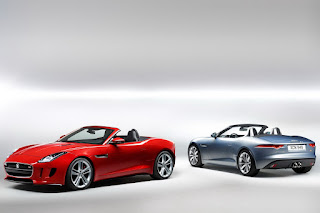The front-engined, rear-wheel drive convertible was previewed at the 2011 IAA by the C-X16 concept. Despite that concept being a coupe, the F-Type, which is a soft-top convertible, remains remarkably faithful to the concept.
Jaguar claims that its models have “always defined sinuous, muscular simplicity”, adding that the F-Type follows the same principles.
“A piece of design should tell a story and this is why every line in the F-Type has a start, a direction and a conclusion”, said the brand’s director of design Ian Callum. “If you approach every line individually and get it as aesthetically correct as possible, get the dimensions right, it will stand the test of time”, he added.
Despite being touted as the spiritual successor to the iconic E-Type, the shape of the F-Type is anything but retro. In fact, even though Jaguar mentions the clamshell bonnet and its “power bulge” in an effort to connect the two models, the F-Type breaks with tradition by having an angular, instead of an oval, grille.
The same holds true for the interior, which is labeled by Jaguar as a “one plus one”. That’s not to say that the passenger’s seat is close to useless, as in 2+2 seaters, but that the cabin is focused around the driver whose space is defined by the swooping handle at the center console and the different, more “technical” materials used on this side of the dashboard.
Both the chassis and the bodywork are constructed of aluminum in order to keep weight as low as possible while increasing rigidity by more than 30 percent in key areas compared to any otherJaguar model. The suspension features aluminum double wishbones all around and the steering has a quick rack for immediate response to the driver’s input.
Jaguar’s new sports car will be available at launch in three versions: the F-Type, the F-Type S and the F-Type V8 S.
The first two are powered by a new supercharged 3.0-liter V6. Output is 340 PS (335 HP) for the base model and 380 PS (375 HP) for the S, with the former covering the 0-60 mph sprint in 5.1 seconds (0-100 km/h: 5.3 seconds) and the latter in 4.8 seconds (0-100 km/h: 4.3 seconds) respectively. The S has a top speed of 275 km/h (171 mph), 15 km/h (10 mph) more than the base V6.
The supercharged V8 is a newly developed unit that pumps out 495 PS (488 HP) and 625 Nm (460.9 lb-ft) of torque. The top-of-the –range F-Type V8S accelerates from a standstill to 60 mph in 4.2 seconds (0-100 km/h: 4.3 seconds) and reaches an electronically governed top speed of 300 km/h (185 mph).
In all versions, power is transferred to the rear wheels via an eight-speed “Quickshift” auto transmission, with the V6 S sporting a Dynamic Launch feature.
The F-Type may retain the “hidden” air vents of the XF and XJ, but it foregoes their rising circular gear selector for a new, more conventional unit that the company compares to a joystick.
In the UK, pricing starts at £58,500 (€73,473, US$94,500) for the V6, £67,500 (€84,777, US$109,100) for the V6 S and £79,950 (€100,391, US$129,200) for the V8 S and the first cars will be delivered to customers from mid-2013.
Expect U.S. prices to be lower when Jaguar makes an announcement in the coming months.
You can check out the extensive image gallery and the first official video (without any comuflage, that is) of the new Jaguar F-Type right after the break.










































0 comments:
Post a Comment